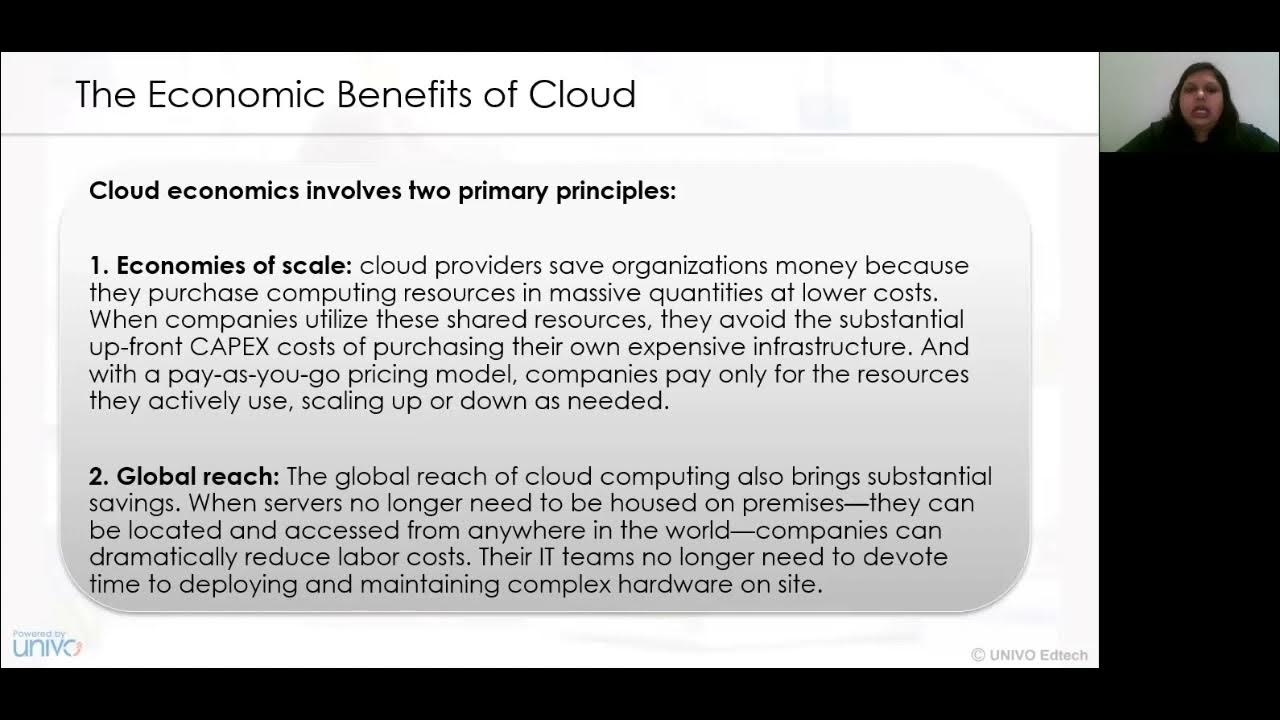Cloud Computing Costs and ROI
Summary
TLDRIn this video, Alistar Croll discusses the core aspects of cloud computing costs, focusing on three key elements: upfront, fixed, and variable spending. He explains how cloud providers benefit from efficiencies in silicon, networking, and storage, leading to lower marginal costs. Croll highlights the increasing economic advantages of cloud computing and contrasts these with traditional IT models. He also emphasizes the revenue-generating potential of cloud adoption, which enables businesses to become more agile and connect with customers. Finally, he invites viewers to join the CloudConnect conference, where cloudonomics and the ROI of cloud computing will be explored in-depth.
Takeaways
- 😀 Cloud computing costs can be broken down into three categories: upfront costs, fixed costs, and variable costs.
- 😀 Upfront costs (CapEx) refer to the initial investment required to get into cloud computing, often mitigated in the public cloud model where businesses pay as they go.
- 😀 Fixed costs are ongoing expenses that do not change with usage, such as personnel and infrastructure maintenance, and may still apply even when using cloud services.
- 😀 Variable costs in the cloud scale with usage, and cloud providers benefit from economies of scale, offering lower costs per unit compared to internal enterprise operations.
- 😀 Cloud providers achieve significant efficiencies by leveraging advancements in three core areas: silicon (computing power), bandwidth (networking), and storage (data management).
- 😀 Moore's Law ensures that computing power continues to improve, making cloud services more efficient and cost-effective over time.
- 😀 Networking costs are rapidly decreasing, with cloud providers able to transfer data at much lower costs (e.g., Netflix's data transfer costs dropping from six cents to three cents).
- 😀 Storage technology is also improving, further driving down cloud service costs, allowing for more efficient use of resources.
- 😀 Cloud computing is transitioning from a simple cost-saving tool to a core business strategy, enhancing agility, innovation, and revenue generation for companies.
- 😀 The upcoming CloudConnect conference will cover 'Cloudonomics,' a detailed analysis of cloud costs and revenues, featuring insights from industry expert Joe Weinman and other thought leaders.
Q & A
What are the three main types of costs associated with cloud computing?
-The three main types of costs in cloud computing are: 1) Upfront Costs (Capex) - initial investment to get started; 2) Fixed Costs - ongoing, unavoidable expenses; 3) Variable Costs - costs that scale with usage.
What is the key advantage of cloud computing in terms of upfront costs?
-Cloud computing eliminates the need for large upfront investments in infrastructure, as companies only pay for the resources they use, avoiding capital expenditures (Capex).
What is the difference between fixed costs in internal systems and those in cloud systems?
-Fixed costs in internal systems, such as staffing and infrastructure maintenance, cannot be avoided even with reduced usage. In cloud systems, fixed costs are typically lower but still exist, like provisioning and policy management.
Why do cloud providers have lower variable costs compared to enterprises running internal systems?
-Cloud providers benefit from economies of scale, allowing them to operate more efficiently. They can share resources across multiple clients, negotiate better deals, and write custom tools to optimize costs.
What technological advancements are driving down the costs of cloud computing?
-Key advancements include improvements in silicon (Moore's Law), networking (cheaper data transfer costs), and storage (more efficient use of materials like iron particles), all of which are becoming cheaper and more efficient annually.
How do the three materials—silicon, iron, and glass—affect cloud computing costs?
-These materials are essential to cloud computing infrastructure. Silicon powers computing hardware, iron particles help with storage, and glass (fibers) are used for networking. As their efficiency increases, the overall cost of cloud services decreases.
What is the concept of 'cloudonomics' mentioned in the transcript?
-'Cloudonomics' refers to the economics of cloud computing, focusing on the cost structures and revenue impacts of cloud adoption. It looks at how businesses can benefit financially from using cloud services, beyond just reducing costs.
How does cloud computing contribute to business agility and revenue growth?
-Cloud computing allows businesses to innovate and scale quickly, experiment with new ideas, and better engage with customers, all of which lead to increased revenue, not just cost savings.
Why might an enterprise still struggle to match the efficiency of cloud providers?
-Enterprises may adopt cloud-like models internally, but they won't have the same scale or specialized tools that cloud providers use. Cloud providers can operate more efficiently because cloud computing is their core business.
What key insights will be covered in the CloudConnect conference regarding cloudonomics?
-The CloudConnect conference will feature Joe Weinman, who coined the term 'cloudonomics,' and will delve into the underlying cost structures of cloud computing, its revenue potential, and offer surprising insights from experts on the financial aspects of cloud services.
Outlines

Dieser Bereich ist nur für Premium-Benutzer verfügbar. Bitte führen Sie ein Upgrade durch, um auf diesen Abschnitt zuzugreifen.
Upgrade durchführenMindmap

Dieser Bereich ist nur für Premium-Benutzer verfügbar. Bitte führen Sie ein Upgrade durch, um auf diesen Abschnitt zuzugreifen.
Upgrade durchführenKeywords

Dieser Bereich ist nur für Premium-Benutzer verfügbar. Bitte führen Sie ein Upgrade durch, um auf diesen Abschnitt zuzugreifen.
Upgrade durchführenHighlights

Dieser Bereich ist nur für Premium-Benutzer verfügbar. Bitte führen Sie ein Upgrade durch, um auf diesen Abschnitt zuzugreifen.
Upgrade durchführenTranscripts

Dieser Bereich ist nur für Premium-Benutzer verfügbar. Bitte führen Sie ein Upgrade durch, um auf diesen Abschnitt zuzugreifen.
Upgrade durchführenWeitere ähnliche Videos ansehen

AWS-Cloud Practitioner Course-004-Section1-Cloud Computing Benefits

ANALISIS PERILAKU BIAYA

benefits of cloud computing

41 - Ponto de equilíbrio contábil, econômico e financeiro. (Contabilidade)

Perilaku Biaya | Wahyu Pramesti, S.E., M.Si,. Ak., C.A

Cloud Economics Cloud Computing infrastructures available for implementing cloud based services
5.0 / 5 (0 votes)
